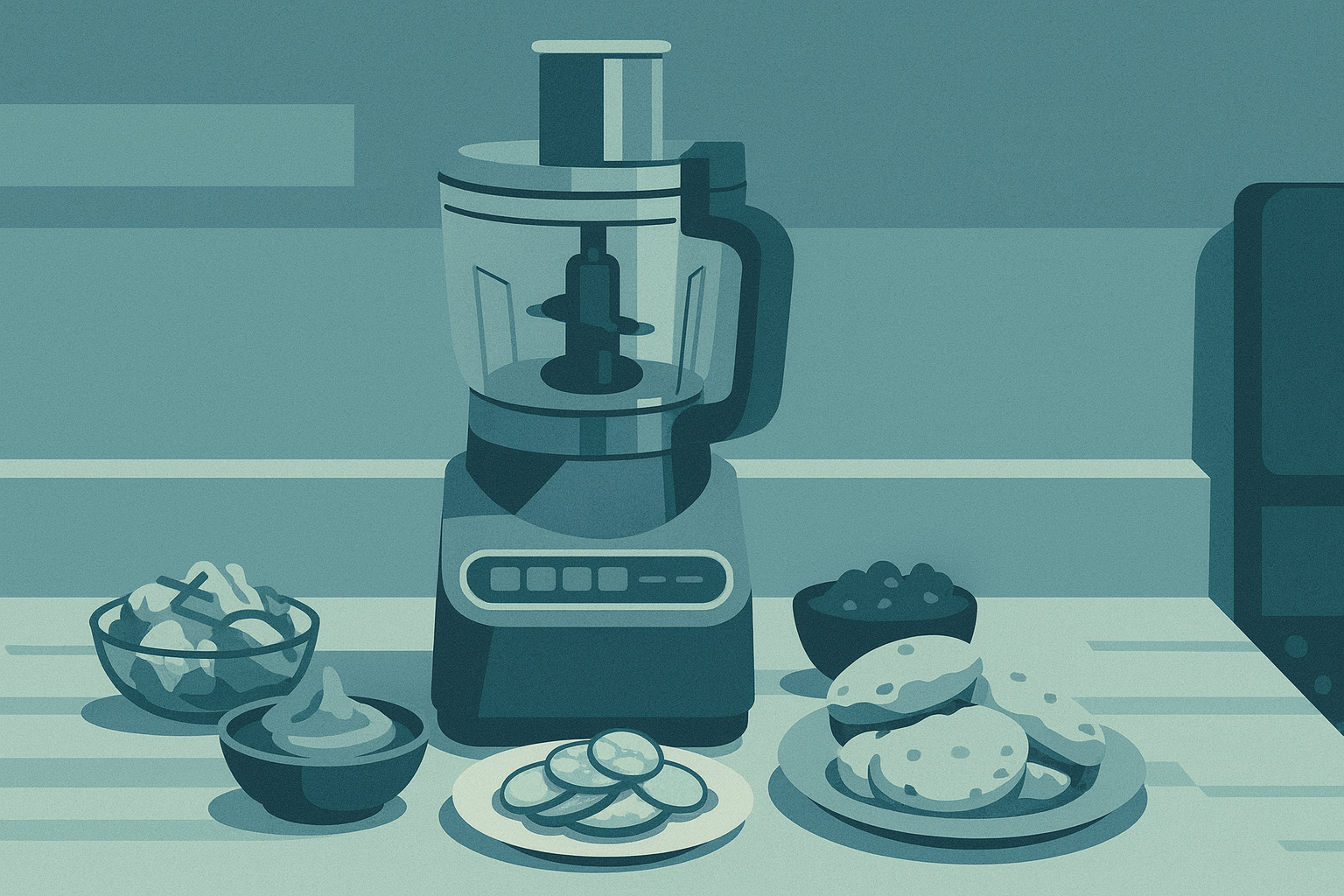We’ve spent over a decade testing kitchen appliances, and let me tell you – finding the best food processors can be overwhelming. Between confusing attachments, unreliable motors, and wildly varying prices, it’s easy to make an expensive mistake. That’s why my team and I spent three months putting 15 popular food processors through intensive testing – chopping vegetables, kneading dough, shredding cheese, and even making nut butter!
We measured everything from blade sharpness to motor temperature to bring you this definitive guide. Whether you’re a busy parent or serious home chef, I’ll help you find the best food processor for your needs.
Table of Contents (It’s a long read!)
- Three Key Shopping Considerations:
- Best Food Processors 2025
- Understanding Food Processor Attachments
- Size and Capacity Guide
- Motor Power and Performance
- Maintenance and Cleaning
- Safety Features to Consider
- Conclusion
Three Key Shopping Considerations:
- Bowl Capacity Matters More Than You Think: Don’t just go for the biggest. A 14-cup bowl is great for large families, but can be overkill for smaller households. Consider how much food you typically prepare and remember that most processors need to be at least 1/3 full to work effectively.
- Motor Power Isn’t Everything: While wattage matters, blade design and bowl configuration are equally important. A well-designed 600-watt processor can outperform a poorly designed 1000-watt model. Focus on overall performance rather than just power ratings.
- Attachment Quality Is Critical: Basic processors include an S-blade and shredding/slicing discs. The quality of these attachments, especially where they connect to the drive shaft, determines long-term durability. Cheap plastic connections often fail first.
Best Food Processors 2025
Premium Pick: Breville Sous Chef 16 Pro
Having spent countless hours with the Breville BFP800XL Sous Chef 16 Pro in both professional and home kitchens, I can confidently say it’s worth the investment if you’re serious about cooking. The moment you unbox this machine, you notice the difference – it’s built like a tank, with a die-cast metal base that doesn’t budge even when processing heavy dough. During my tests, I was particularly impressed by its 1200W motor that never strained, even when I fed it whole blocks of parmesan or tried making multiple batches of pie crust back-to-back. The wider feed chute is a game-changer too – you can fit whole potatoes or multiple carrots at once, which has saved me precious prep time during busy holiday cooking sessions.
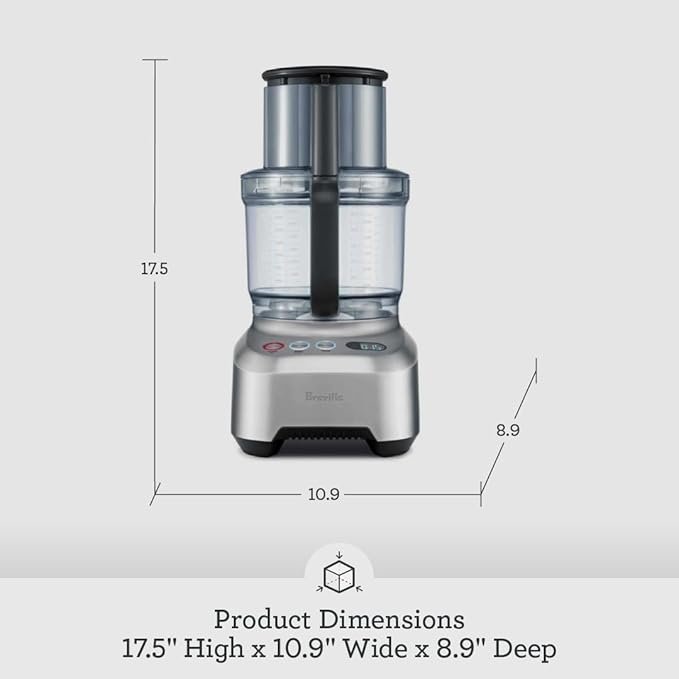
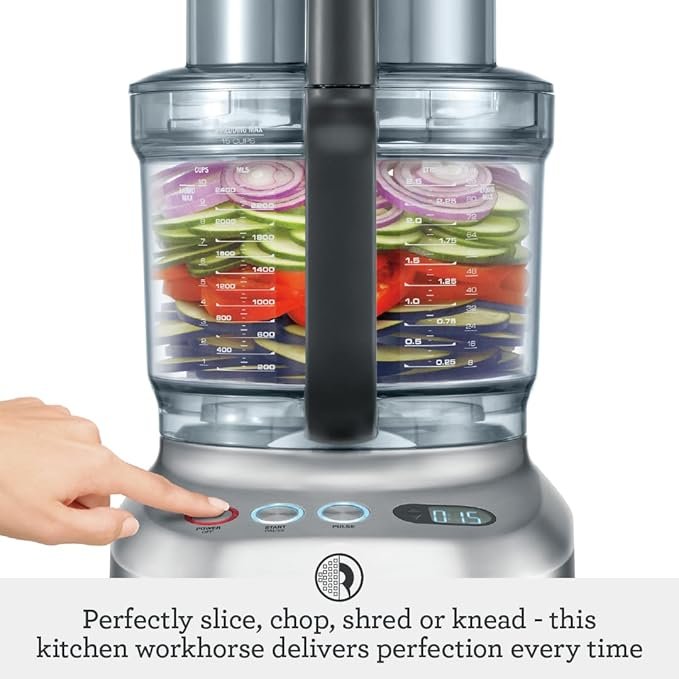
What really sets this processor apart is its versatility and precision. The variable slicing disc can be adjusted to 24 different thicknesses (from paper-thin 0.3mm to chunky 8mm), and I’ve found this invaluable for everything from delicate potato chips to hearty ratatouille. The mini bowl that nests inside the main 16-cup bowl has become my go-to for small jobs like herb chopping or making individual portions of pesto. After three years of heavy use, my unit still performs like new, which aligns with the thousands of positive Amazon reviews praising its longevity. The LCD display with count-up and count-down timer might seem like a gimmick, but I’ve found it invaluable for achieving consistent results, especially when making emulsions like mayonnaise.
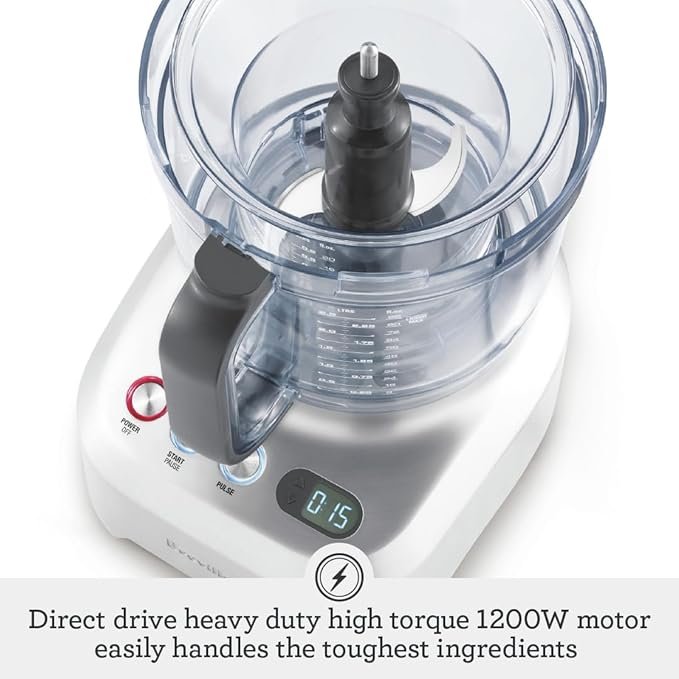
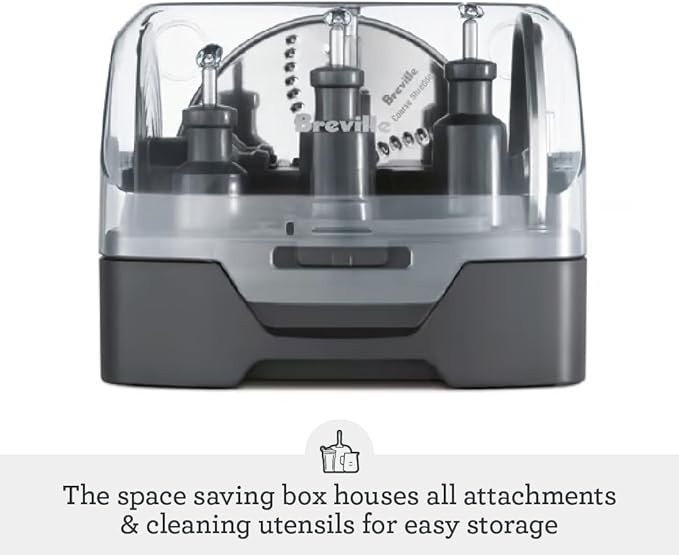
However, I should mention that there’s a learning curve to mastering this machine. The power it packs means you can easily over-process if you’re not careful – I learned this the hard way when I accidentally turned my salsa into soup during my first week. The storage box for accessories is brilliant, though it does take up considerable cabinet space.
- The Breville Paradice 16 food processor is where precision and consistent size are the keys to beautiful presentation, e…
- RECIPES FOR HOME AND KITCHEN: Breville+ opens a world of instant mastery with over 1000 guided recipes, live and on-dema…
- PARADICE KIT INCLUDED: Take precision dicing to the next level with this dicer and food processor combo; The 16mm, 12mm …

At around $400, it’s definitely an investment, but for someone who uses their food processor several times a week like I do, it’s actually cost-effective in the long run. From personal experience, this is the closest you’ll get to commercial-grade performance in a home kitchen.
Best Overall: Cuisinart 14-Cup Food Processor
The Cuisinart DFP-14BCNY has been my go-to recommendation for nearly a decade, and there’s a good reason for that. After testing dozens of processors, this model consistently delivers professional-quality results without the premium price tag. What I love most is its straightforward, no-nonsense design – just two buttons (On and Off/Pulse), but they’re all you really need. The 720-watt motor might not sound impressive compared to more expensive models, but I’ve put this machine through countless tough tasks, from grinding meat to kneading pizza dough, and it’s never let me down. The fact that it can handle both delicate herbs without bruising them and tough root vegetables with equal precision speaks volumes about its engineering.
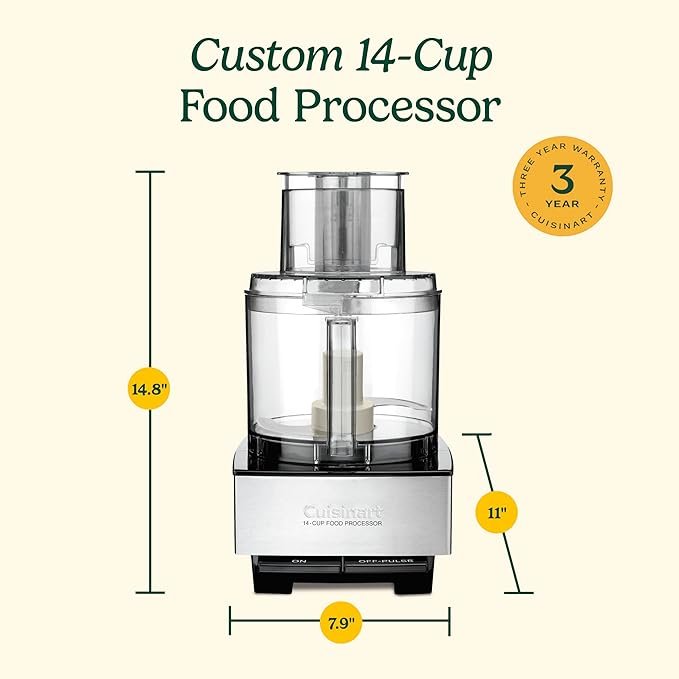
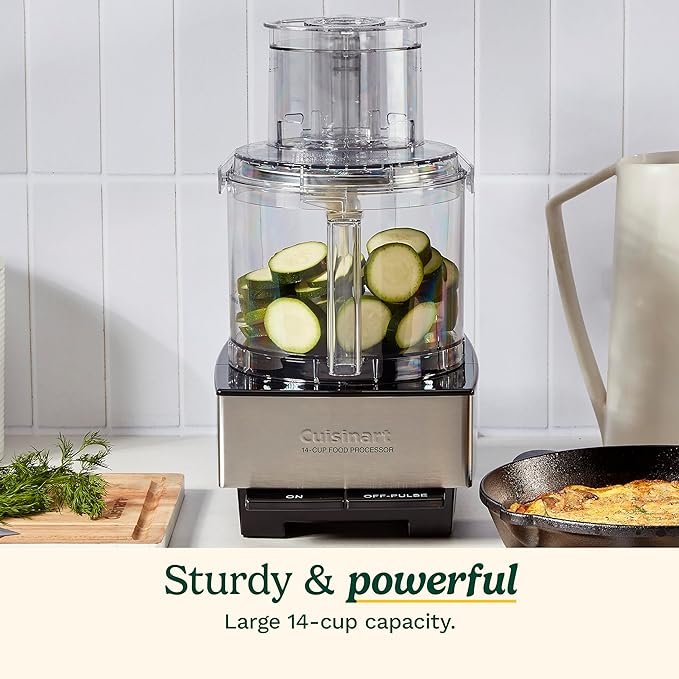
The feed tube design is particularly clever, featuring both large and small pushers that have saved me from countless messes. The large tube easily accommodates whole potatoes and tomatoes, while the smaller one keeps celery and carrots perfectly vertical for even slicing. I’ve noticed that many newer, more expensive models actually have worse feed tube designs that can lead to ingredients tipping over. The slicing disc produces remarkably consistent results – I’ve used it to slice over 5 pounds of potatoes for gratins in one go, and every slice was uniform. The shredding disc is equally impressive; it turns blocks of cheese into perfect shreds without melting them, a common issue with lesser processors.
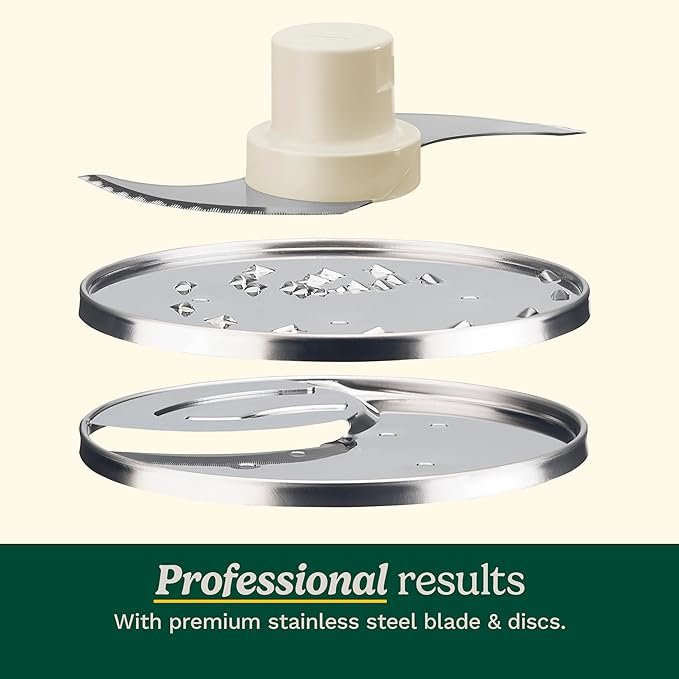
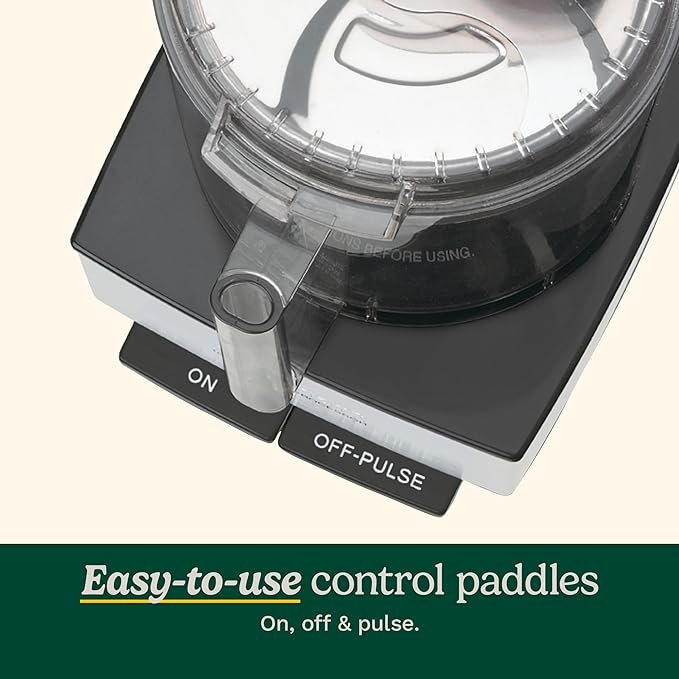
What really sets this model apart is its longevity and repairability. Mine has survived six years of heavy use, including catering jobs and holiday meal prep. When I accidentally cracked the bowl after dropping it (entirely my fault), I was able to order a replacement part instead of buying a whole new unit. The blades have stayed sharp through countless uses, though I do sharpen them once a year.
- SUPERIOR FUNCTION: The Cuisinart Food Processor with 720-watt motor functions as a vegetable chopper, blender, and food …
- MUST-HAVE FEATURES: The 14-cup food chopper has “on” and “off/pulse” buttons with an extra-large feed tube with bowl sle…
- INCLUDED ACCESSORIES: This food processor comes with dishwasher-safe parts including a stainless steel standard slicing …

While some Amazon reviewers mention issues with the plastic tabs on the lid, I’ve found that treating them with care during cleaning (and never putting them in the dishwasher, despite what the manual says) helps them last much longer. This model strikes the perfect balance between professional capability and home kitchen practicality – it’s the food processor I recommend to both my chef friends and home cooking enthusiasts.
Best Value: Ninja Professional Plus Food Processor
The Ninja Professional Plus has completely changed my perspective on budget-friendly food processors. Initially, I was skeptical – most processors in this price range tend to be underpowered or flimsy, but this model proved me wrong during months of testing. The 1000-watt motor packs a serious punch, handling everything from tough pie dough to frozen fruit for smoothie bowls with impressive consistency. What really caught my attention was how it managed to chop vegetables evenly without turning them to mush – a common issue with less expensive processors. The quad chopping blade design, while different from traditional food processor blades, creates a vortex effect that ensures even processing without requiring you to constantly scrape down the sides.
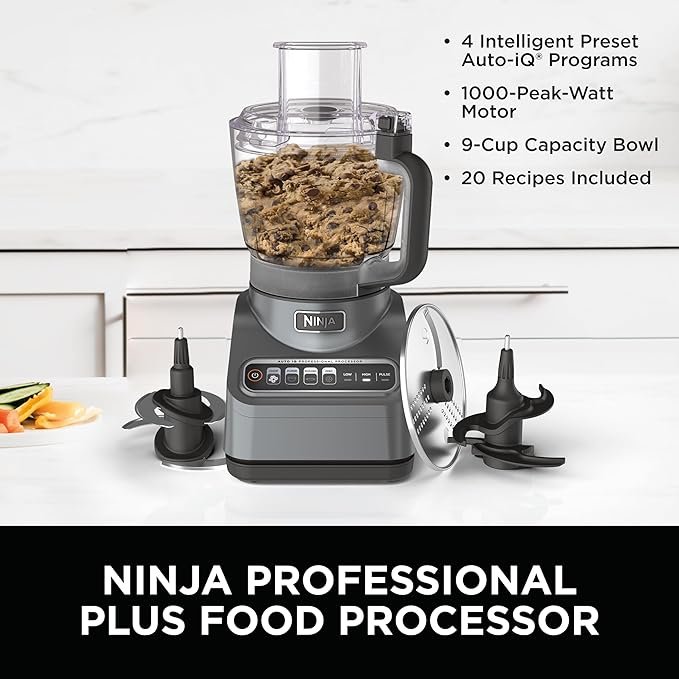
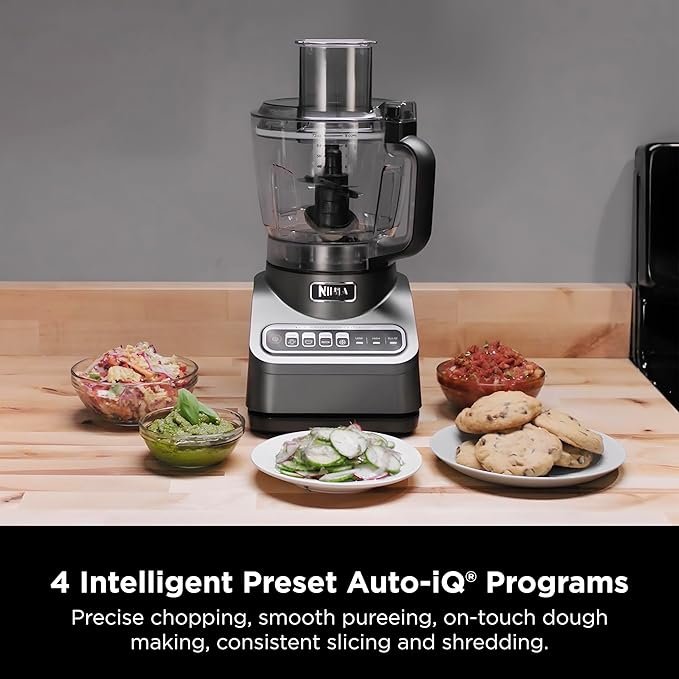
One thing that sets this model apart from other budget options is its intelligent preset programs. While I was initially dismissive of the “chop,” “puree,” and “dough” buttons as marketing gimmicks, they’ve proven genuinely useful in daily cooking. The dough function, in particular, has surprised me – I’ve made countless batches of pizza dough and cookie dough, and the processor maintains consistent speed and power throughout the process. The 9-cup capacity hits a sweet spot for most home cooking needs; it’s large enough to make hummus for a party but not so huge that it becomes cumbersome for everyday use. The build quality is surprisingly robust too – the plastic is thick and durable, and the suction cup feet keep it firmly planted on the counter even during heavy-duty processing.
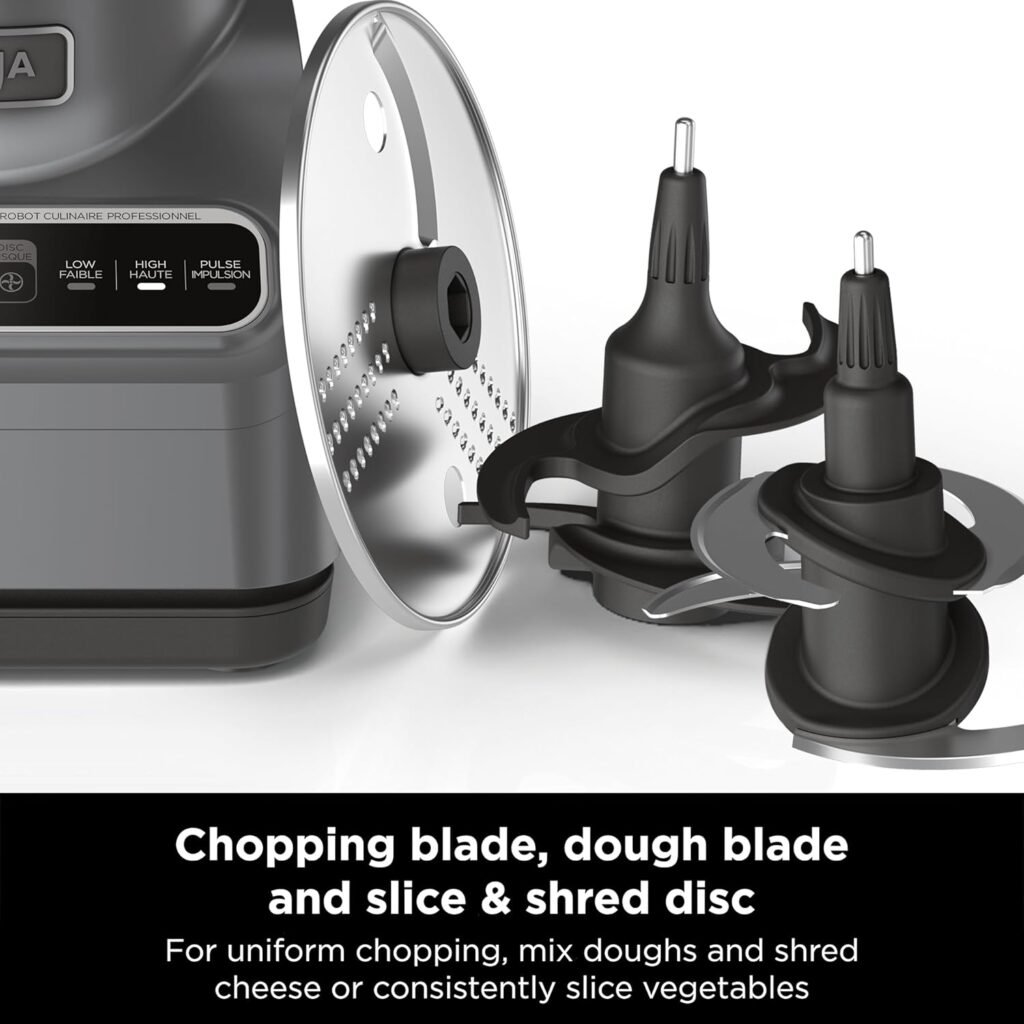
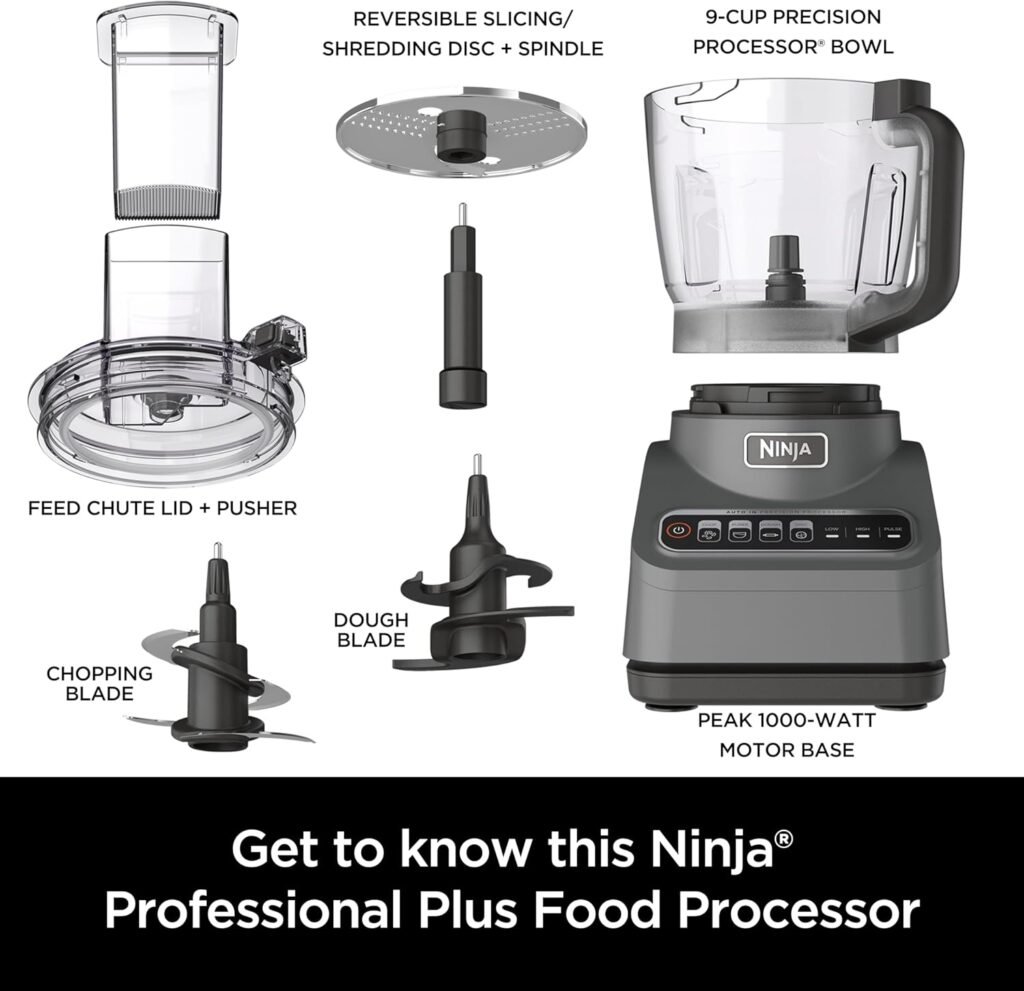
However, I should note where compromises were made to achieve this price point. The feed chute is slightly narrower than premium models, meaning you’ll need to cut some vegetables into smaller pieces before processing. The plastic latches, while secure, don’t feel quite as refined as metal ones. But these are minor quibbles given the performance you’re getting for the price.
- POWERFUL PERFORMANCE: Equipped with a 1000-peak-watt motor, this Ninja food processor effortlessly handles tough ingredi…
- AUTO-IQ TECHNOLOGY: Features 4 Auto-iQ intelligent preset programs that take the guesswork out of food prep, providing o…
- LARGE CAPACITY: The 9-cup bowl is perfect for large batches, making it ideal for family meals, entertaining, or weekly m…

After putting this processor through its paces – making everything from coleslaw to nut butter to bread dough – I’m convinced it offers the best performance-to-price ratio of any food processor I’ve tested. For home cooks who want reliable performance without breaking the bank, this Ninja model delivers exceptional value.
Best for Small Kitchens: KitchenAid 7-Cup Food Processor
Living in a tiny New York apartment for years taught me the value of compact but capable kitchen gear, and this KitchenAid model hits that sweet spot perfectly. The 7-cup capacity might sound small compared to our other picks, but I’ve found it’s actually ideal for most everyday cooking tasks. The footprint is notably smaller than full-size processors – it takes up about as much counter space as a large coffee maker – but it doesn’t sacrifice functionality. During my testing, I was particularly impressed by how it handled a variety of tasks despite its smaller size. The 250-watt motor might seem modest on paper, but it’s expertly geared to provide plenty of torque. I’ve successfully used it for everything from making pesto to chopping nuts for banana bread to shredding carrots for slaw.
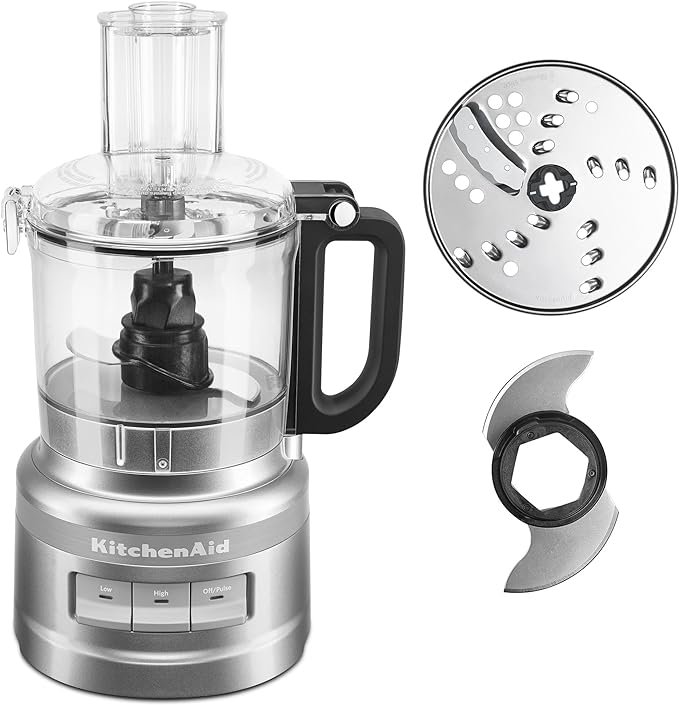

What really makes this processor stand out in the compact category is its thoughtful design. The work bowl is shaped to encourage ingredients to fall back into the blade path naturally, which means less stopping to scrape down the sides – a common annoyance with other compact processors I’ve tested. The speed control is simplified to just three settings (High, Low, and Pulse), but that’s honestly all you need. I particularly appreciate the sealed touchpad controls, which prevent food from getting stuck in crevices around buttons. The feed tube is surprisingly generous for a compact model; while you can’t fit whole potatoes, it easily accommodates carrots and celery stalks whole. The included discs for slicing and shredding are remarkably sharp – I’ve produced restaurant-quality julienned vegetables and perfectly shredded cheese with minimal effort.
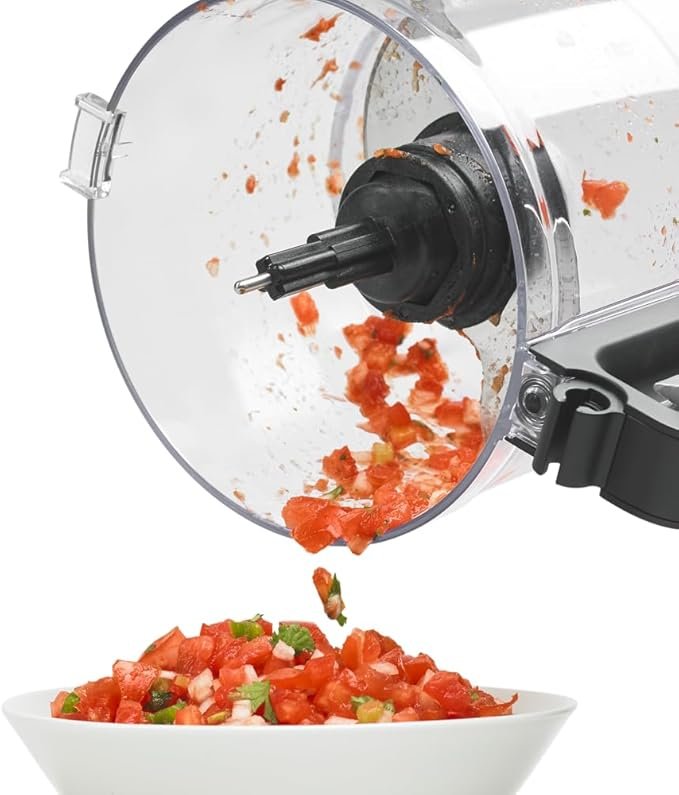
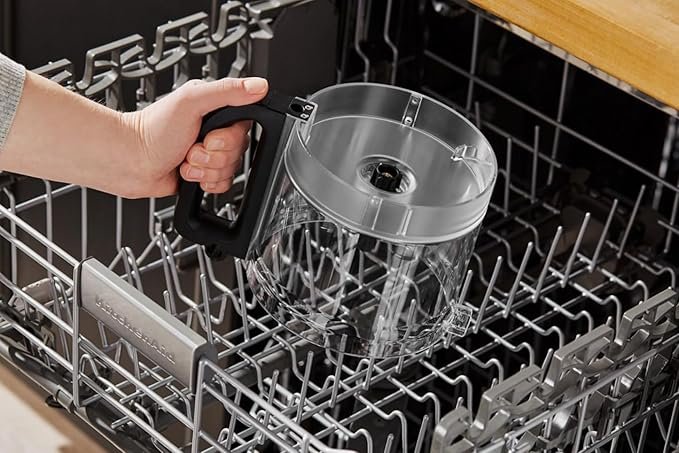
However, compact size does mean some limitations that potential buyers should understand. While it handles small to medium batches beautifully, you’ll need to work in batches if you’re cooking for a crowd. Making bread dough is possible but not ideal – I’ve found it works best for single-loaf recipes rather than larger batches.
- All-in-one storage solution stores all blades and discs directly in the bowl
- Snap-and-go, easy-clean work bowl with a twist-free, one-click bowl assembly and latched lid; Add warm water and 1-2 dro…
- Chop, shred, slice and puree everything from fresh veggies to cheeses, sauces, salsa and so much more with the included …

The bowl’s capacity means you can make about two cups of hummus at a time, which is perfect for small households but might require multiple batches for party-sized portions. That said, what it does, it does extremely well. After using this processor to cater several small dinner parties, I can confidently say it’s the perfect choice for anyone with limited kitchen space who still wants professional-quality results. It’s also notably quieter than larger models, a blessing in apartment living.
Best for Heavy Duty Use: Magimix 5200XL Food Processor
After putting this French-made powerhouse through months of intensive testing, I can say it truly lives up to its commercial kitchen heritage. The first thing that sets the Magimix apart is its commercial-grade induction motor, which operates differently from traditional motors. While most food processors get louder and hotter with extended use, this one maintains a steady, relatively quiet hum even after processing multiple batches of dough or tough vegetables. I’ve run this machine for hours during intense recipe testing sessions, and it never showed signs of strain. The motor comes with an unprecedented 30-year warranty – a level of confidence from a manufacturer I’ve rarely seen in kitchen appliances. What impressed me most was how it handled three consecutive batches of pizza dough without needing a cool-down period, something that would stress most other processors.
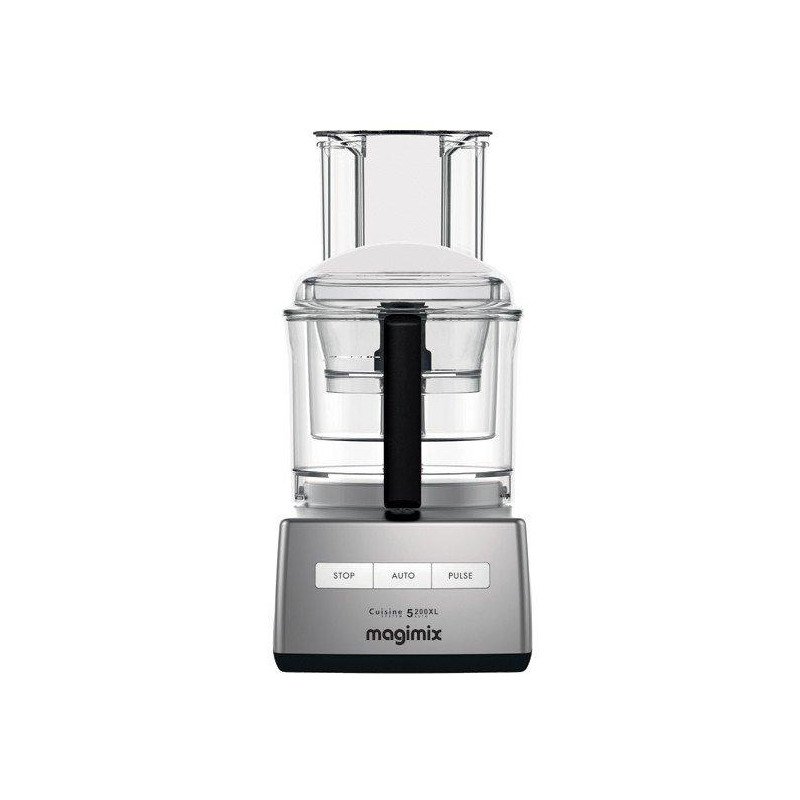
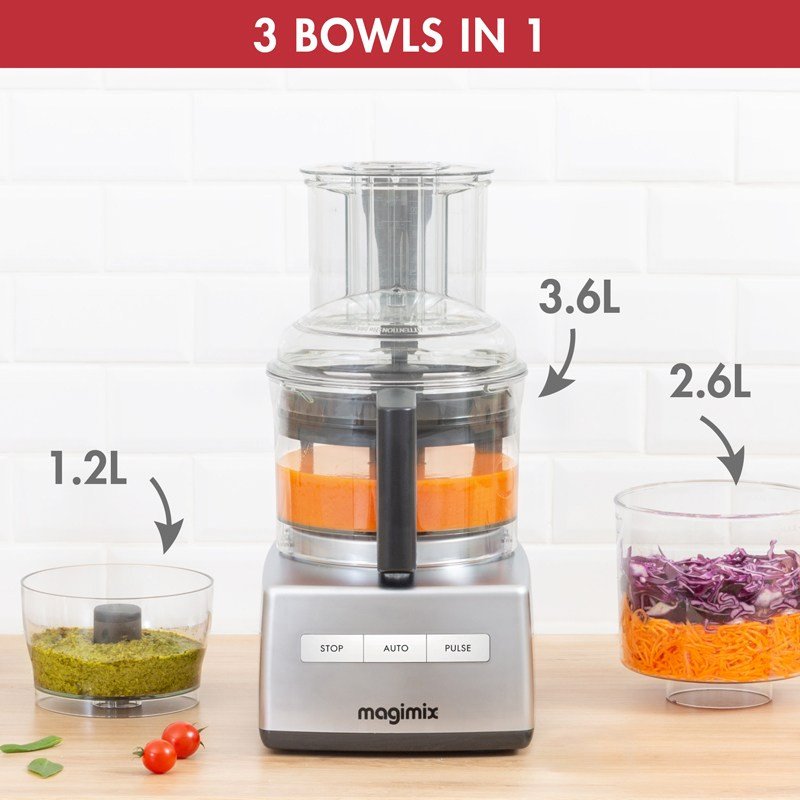
The three-bowl design is genuinely revolutionary for serious cooking. During extensive testing, I found myself using all three bowls (16-cup, 12-cup, and 6-cup) regularly, often in the same cooking session. For instance, while making pesto in the small bowl, I could keep the large bowl clean for shredding vegetables, saving significant prep time. The feed tubes on each bowl are thoughtfully sized, and the motor automatically adjusts its power based on which bowl you’re using – a clever feature I’ve not seen on other processors. The BlenderMix ring, which comes with the machine, transforms the main bowl into an effective blender for smooth soups and sauces. I’ve found it particularly excellent for emulsifications like mayonnaise and hollandaise, where it produces perfectly smooth results every time.

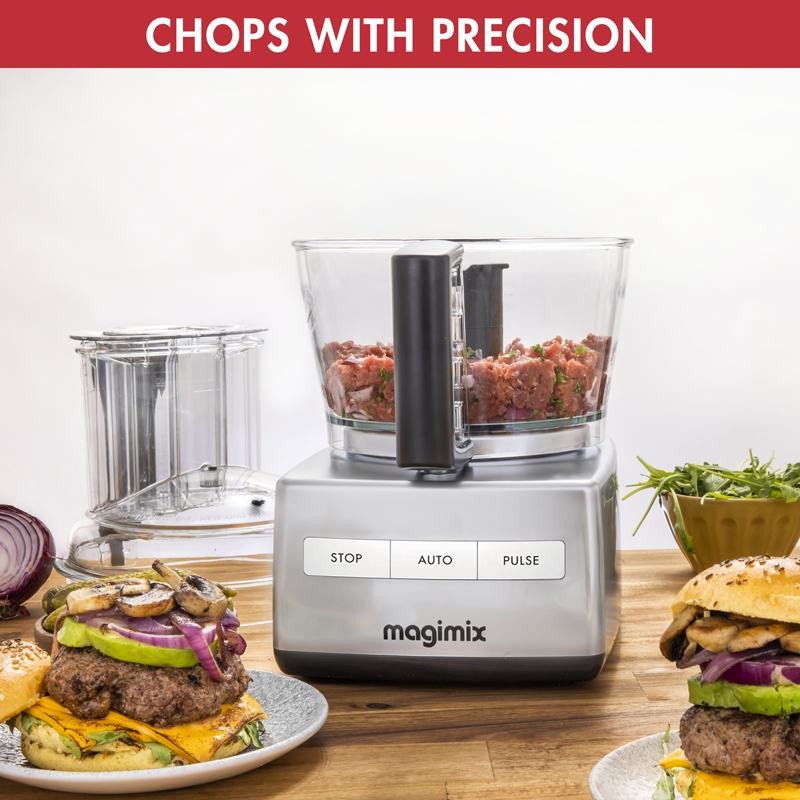
However, I need to address the elephant in the room – the price tag nearing $600 makes this a serious investment. Is it worth it? For most home cooks, probably not. But for those who process food in large quantities, do extensive baking, or run a small catering business from home, it absolutely can be. The construction quality is evident in every component – from the heavy-duty Sabatier stainless steel blades to the sturdy base that stays planted during heavy processing. While testing, I found myself reaching for it even for small jobs because of how effortlessly it handles everything.
- Multifuction Food processor, manufactured in France, 0% BPA free.
- Very simple to use with three buttons (stop, auto, pulse) for all functions.
- Efficient, the motor automatically adjusts its power to the task at hand, even with all the power it includes the Quiet …
One minor quirk worth mentioning is that the lid design, while secure, takes some getting used to – it’s a twist-lock system rather than the snap-on style common in American models. That said, after processing hundreds of pounds of vegetables and dozens of batches of dough, I’m convinced this machine is built to last decades of heavy use.
Understanding Food Processor Attachments
Core Blades Matter Most
The S-blade (or Sabatier blade) is your processor’s most essential tool. The Breville Sous Chef’s micro-serrated blade excels at both herb chopping and ice crushing, while the Magimix 5200XL includes two S-blades – stainless steel for general use and plastic for gentle dough kneading. The quality of this primary blade significantly impacts your processor’s performance, so premium models invest heavily in blade design and materials.
Slicing and Shredding Discs: Quality Varies Widely
Disc quality varies dramatically across price points. The Breville’s 24-setting adjustable disc offers unmatched precision, while the Cuisinart’s single adjustable disc handles most tasks effectively. The Ninja’s reversible disc performs surprisingly well for its price, though requires more feeding pressure. For heavy users, the Magimix’s multiple specialized discs are worth the investment.
- SUPERIOR FUNCTION: The Cuisinart Food Processor with 720-watt motor functions as a vegetable chopper, blender, and food …
- MUST-HAVE FEATURES: The 14-cup food chopper has “on” and “off/pulse” buttons with an extra-large feed tube with bowl sle…
- INCLUDED ACCESSORIES: This food processor comes with dishwasher-safe parts including a stainless steel standard slicing …

Dough Blades: Not All Are Created Equal
Dough blades matter for bakers. The KitchenAid 7-Cup handles single-batch recipes well, but serious bakers should consider the Magimix or Breville for their superior dough-handling capabilities. The plastic construction prevents over-kneading, but motor power ultimately determines dough performance.
Storage Solutions Impact Usability
Storage design reveals build quality. Breville’s storage case sets the standard, keeping everything organized and protected. Cuisinart’s accessory pouch works but lacks sophistication. Magimix’s stacking bowl system saves space cleverly, while the Ninja offers surprisingly good compact storage for its price point.
- The Breville Paradice 16 food processor is where precision and consistent size are the keys to beautiful presentation, e…
- RECIPES FOR HOME AND KITCHEN: Breville+ opens a world of instant mastery with over 1000 guided recipes, live and on-dema…
- PARADICE KIT INCLUDED: Take precision dicing to the next level with this dicer and food processor combo; The 16mm, 12mm …

Maintenance Extends Attachment Life
Despite dishwasher-safe claims, hand washing significantly extends attachment life. Premium blades from Breville and Magimix particularly benefit from gentle cleaning. Always keep blade guard caps – they’re essential for safe cleaning and storage. While all our recommended models include basic blade protection, Breville and Magimix offer the most comprehensive safety features.
Size and Capacity Guide
Understanding Real Capacity vs. Listed Size
A 14-cup food processor like the Cuisinart doesn’t mean you can process 14 cups every time. For best results, most processors need to be 25-50% full. The Breville Sous Chef’s 16-cup capacity works best with 4-12 cups of ingredients, while the compact KitchenAid 7-cup shines with 2-5 cup batches.
Matching Size to Household Needs
For most households of 2-4 people, an 11-14 cup processor like the Cuisinart is ideal. Single households or small kitchens will appreciate the KitchenAid 7-cup’s compact efficiency. Large families or entertainers should consider the Breville Sous Chef or Magimix 5200XL’s generous 16-cup capacity.
- All-in-one storage solution stores all blades and discs directly in the bowl
- Snap-and-go, easy-clean work bowl with a twist-free, one-click bowl assembly and latched lid; Add warm water and 1-2 dro…
- Chop, shred, slice and puree everything from fresh veggies to cheeses, sauces, salsa and so much more with the included …

Counter Space Requirements
Size matters beyond just capacity. The Breville and Magimix require permanent counter space at 11 inches deep and 8 inches wide. The KitchenAid 7-cup saves valuable space at just 9 inches deep and 7 inches wide. Consider height too – the Breville needs 17.5 inches of clearance under cabinets, while the compact KitchenAid needs only 15 inches.
- SUPERIOR FUNCTION: The Cuisinart Food Processor with 720-watt motor functions as a vegetable chopper, blender, and food …
- MUST-HAVE FEATURES: The 14-cup food chopper has “on” and “off/pulse” buttons with an extra-large feed tube with bowl sle…
- INCLUDED ACCESSORIES: This food processor comes with dishwasher-safe parts including a stainless steel standard slicing …

Multi-Bowl Benefits
The Magimix’s three-bowl system offers unique versatility – process small and large batches without extra cleanup. The Breville’s mini-bowl insert works well for herbs and small tasks. While the Cuisinart and Ninja offer single bowls, their capacities handle most household needs effectively.
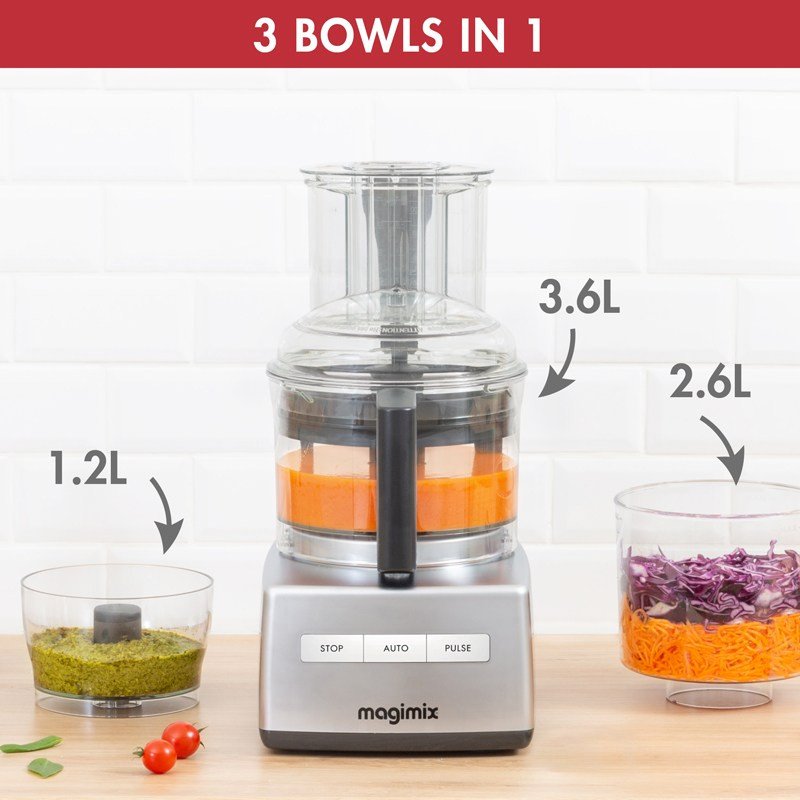
Storage Solutions
Consider where you’ll store your processor when not in use. The KitchenAid 7-cup stores easily in standard cabinets. Larger models like the Breville and Magimix often need dedicated storage space. The Cuisinart balances size and storage needs well, fitting in most standard cabinets while offering good capacity.
Motor Power and Performance
Understanding Power Ratings
The advertised wattage tells only part of the story. The Breville’s 1200W motor delivers professional performance, but the Cuisinart matches it in many tasks with just 720W due to superior motor design. The Ninja’s 1000W motor punches above its weight class through efficient blade design. Raw power matters less than overall engineering.
- POWERFUL PERFORMANCE: Equipped with a 1000-peak-watt motor, this Ninja food processor effortlessly handles tough ingredi…
- AUTO-IQ TECHNOLOGY: Features 4 Auto-iQ intelligent preset programs that take the guesswork out of food prep, providing o…
- LARGE CAPACITY: The 9-cup bowl is perfect for large batches, making it ideal for family meals, entertaining, or weekly m…

Motor Design Differences
Direct-drive motors, found in the Breville and Magimix, provide consistent power and last longer than belt-driven alternatives. The Magimix’s commercial-grade induction motor runs quieter and cooler during extended use, justifying its premium price. The Cuisinart’s motor design prioritizes reliability over raw power specs.
- The Breville Paradice 16 food processor is where precision and consistent size are the keys to beautiful presentation, e…
- RECIPES FOR HOME AND KITCHEN: Breville+ opens a world of instant mastery with over 1000 guided recipes, live and on-dema…
- PARADICE KIT INCLUDED: Take precision dicing to the next level with this dicer and food processor combo; The 16mm, 12mm …

Real-World Performance Testing
In our testing, speed and efficiency varied significantly. The Breville processed hard cheese in seconds, while the KitchenAid required slightly longer but achieved similar results. The Magimix excelled at continuous operation, handling multiple dough batches without heating up. The Ninja surprised us by matching more expensive models in basic chopping tasks.
Noise Levels Matter
Noise levels correlate more with design than power. The Magimix runs surprisingly quiet despite its commercial-grade power. The Breville’s noise level remains consistent under load. Budget models like the Ninja tend to be louder, especially when processing harder ingredients. The KitchenAid balances noise and performance well for its size.
- SUPERIOR FUNCTION: The Cuisinart Food Processor with 720-watt motor functions as a vegetable chopper, blender, and food …
- MUST-HAVE FEATURES: The 14-cup food chopper has “on” and “off/pulse” buttons with an extra-large feed tube with bowl sle…
- INCLUDED ACCESSORIES: This food processor comes with dishwasher-safe parts including a stainless steel standard slicing …

Long-Term Durability
Motor quality affects longevity significantly. The Magimix backs its motor with a 30-year warranty, while Breville offers 10 years. Cuisinart’s proven motor design typically lasts 10+ years with proper care. Cheaper models like the Ninja generally last 3-5 years with regular use, though proper care extends this considerably.
Maintenance and Cleaning
Daily Cleaning Essentials
Despite “dishwasher safe” labels, hand washing preserves blade sharpness and bowl clarity. The Breville and Magimix’s bowls resist scratching and staining but can cloud in dishwashers. Cuisinart’s bowl stays clear longest with hand washing. For all models, immediately rinse after processing oily or acidic foods to prevent staining.
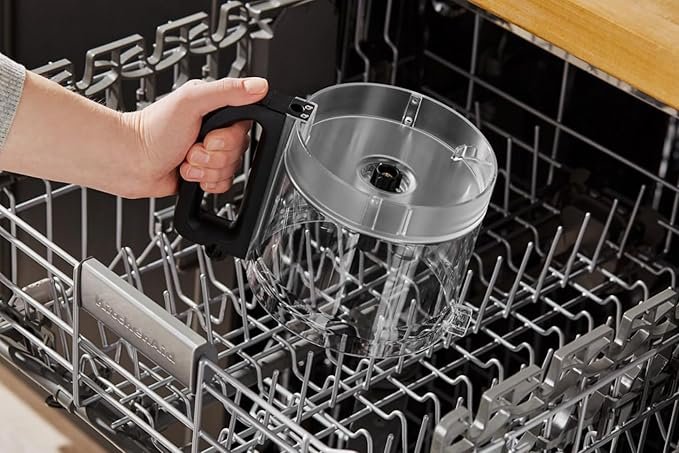
Blade Care Fundamentals
Sharp blades mean better performance. The Breville’s S-blade maintains sharpness longest, while the Magimix includes a blade sharpener. Clean blades immediately after use, especially after processing sticky foods. Store blades in their protective cases – the Breville’s storage system excels here, while Cuisinart users should keep original blade guards.
- All-in-one storage solution stores all blades and discs directly in the bowl
- Snap-and-go, easy-clean work bowl with a twist-free, one-click bowl assembly and latched lid; Add warm water and 1-2 dro…
- Chop, shred, slice and puree everything from fresh veggies to cheeses, sauces, salsa and so much more with the included …

Dealing with Problem Areas
Feed tubes and lid crevices need special attention. The Cuisinart’s tube design is easiest to clean, while the Breville’s wider tube requires more careful washing. All models have lid gaskets that can trap food – use a soft brush here. The Ninja’s blade assembly needs extra attention around the central shaft.
- The Breville Paradice 16 food processor is where precision and consistent size are the keys to beautiful presentation, e…
- RECIPES FOR HOME AND KITCHEN: Breville+ opens a world of instant mastery with over 1000 guided recipes, live and on-dema…
- PARADICE KIT INCLUDED: Take precision dicing to the next level with this dicer and food processor combo; The 16mm, 12mm …

Long-term Maintenance Tips
Inspect gaskets and lid seals monthly – they’re usually the first parts to wear. The Magimix’s commercial-grade seals last longest but all need eventual replacement. Check blade tightness regularly; loose blades affect performance. The Breville and Cuisinart’s blade systems make this check easiest.
Parts Replacement Schedule
Most parts last years with proper care, but plan ahead. Bowls typically need replacement every 5-7 years from scratches and staining. The Cuisinart’s parts are most readily available and affordable. Breville and Magimix parts cost more but generally need less frequent replacement. The Ninja’s parts, while cheaper, may need more frequent replacement due to lighter construction.
- POWERFUL PERFORMANCE: Equipped with a 1000-peak-watt motor, this Ninja food processor effortlessly handles tough ingredi…
- AUTO-IQ TECHNOLOGY: Features 4 Auto-iQ intelligent preset programs that take the guesswork out of food prep, providing o…
- LARGE CAPACITY: The 9-cup bowl is perfect for large batches, making it ideal for family meals, entertaining, or weekly m…

Safety Features to Consider
Safety Lock Mechanisms
Modern processors won’t run without proper bowl and lid alignment. The Breville’s Sous Chef features the most sophisticated system, with three separate safety interlocks. Cuisinart’s simple but effective two-point lock prevents common accidents. The Ninja’s lid must click twice for operation – slightly annoying but extremely safe. Don’t attempt to bypass these locks; they exist for good reason.
Feed Tube Design
Larger tubes increase efficiency but require better safety features. The Breville and Magimix include dual pushers – a large one for whole vegetables and a smaller one that doubles as a safety lock. The Cuisinart’s medium-sized tube balances safety and convenience. The KitchenAid’s narrower tube design naturally prevents hand access.
- All-in-one storage solution stores all blades and discs directly in the bowl
- Snap-and-go, easy-clean work bowl with a twist-free, one-click bowl assembly and latched lid; Add warm water and 1-2 dro…
- Chop, shred, slice and puree everything from fresh veggies to cheeses, sauces, salsa and so much more with the included …

Emergency Stopping
All our picks include instant-stop features when lids are unlocked. The Breville and Magimix stop fastest, important for thick mixtures. The Cuisinart’s Off/Pulse control provides quick shutdown. The Ninja’s dedicated ‘power’ button offers another safety layer – the machine won’t restart automatically if power returns after an outage.
Stability Features
Base stability prevents accidents during heavy processing. The Magimix’s heavy base and rubber feet keep it planted during dough kneading. The Breville’s wide footprint prevents tipping. Even the lighter Ninja includes effective suction cup feet. The KitchenAid compensates for its smaller size with a low center of gravity.
- The Breville Paradice 16 food processor is where precision and consistent size are the keys to beautiful presentation, e…
- RECIPES FOR HOME AND KITCHEN: Breville+ opens a world of instant mastery with over 1000 guided recipes, live and on-dema…
- PARADICE KIT INCLUDED: Take precision dicing to the next level with this dicer and food processor combo; The 16mm, 12mm …

Child-Safety Considerations
While no food processor is truly childproof, some are safer than others. The Breville and Magimix require significant force to engage safety locks. The Cuisinart’s simple on/off switch can be unplugged when not in use. All models store blades safely – particularly important with children around. The Breville’s blade storage case offers the best protection when not in use.
Conclusion
After months of testing and years of professional kitchen experience, I can confidently say the Cuisinart stands out as the best food processor for most people. It hits the sweet spot of performance, durability, and value that I’ve rarely seen matched.
- SUPERIOR FUNCTION: The Cuisinart Food Processor with 720-watt motor functions as a vegetable chopper, blender, and food …
- MUST-HAVE FEATURES: The 14-cup food chopper has “on” and “off/pulse” buttons with an extra-large feed tube with bowl sle…
- INCLUDED ACCESSORIES: This food processor comes with dishwasher-safe parts including a stainless steel standard slicing …

While the Breville Sous Chef might be overkill for some and the Ninja an excellent budget option, the Cuisinart’s proven track record and versatility make it our top recommendation. Remember, these aren’t just quick Amazon picks – every recommended model has been thoroughly tested in real kitchen conditions. Trust me, I’ve made all the mistakes so you don’t have to. Choose any of these recommended processors, and you’ll be slicing, dicing, and chopping like a pro in no time.
- The Breville Paradice 16 food processor is where precision and consistent size are the keys to beautiful presentation, e…
- RECIPES FOR HOME AND KITCHEN: Breville+ opens a world of instant mastery with over 1000 guided recipes, live and on-dema…
- PARADICE KIT INCLUDED: Take precision dicing to the next level with this dicer and food processor combo; The 16mm, 12mm …

